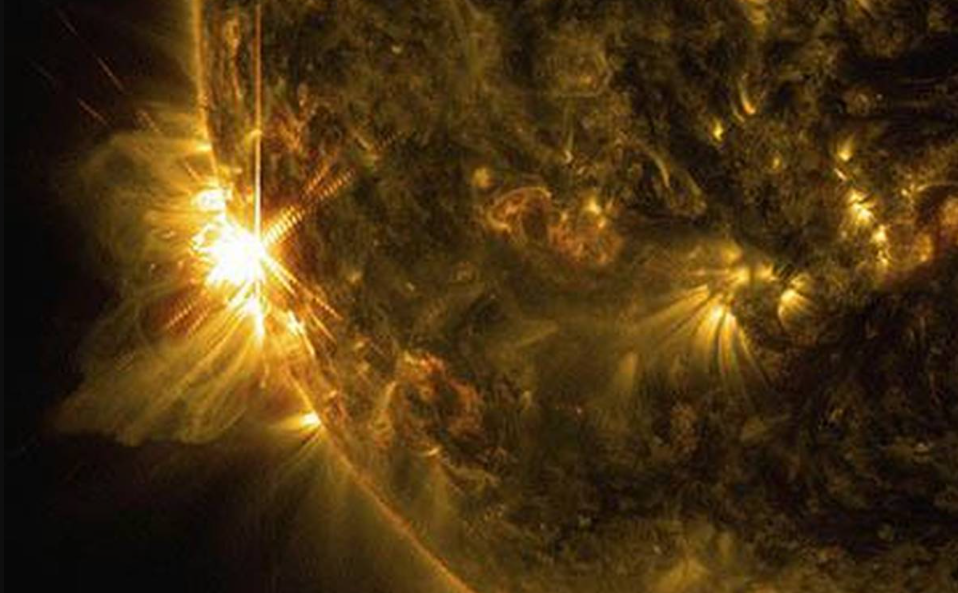
The News Editorial Analysis 4th November 2021
Physicists predict a Solar Deepavali this year.
A solar flare that occurred on the Sun has triggered a magnetic storm which scientists predict will arrive at the Earth in the early hours of November 4
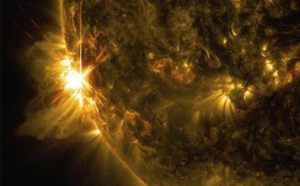
The sun may well add to this year’s Deepavali celebrations, if predictions made by solar physicists come true. A solar flare that occurred on the Sun has triggered a magnetic storm which scientists predict will arrive at the Earth in the early hours of November 4, and this can give rise to spectacular displays of aurora in the polar regions, just in time for the Deepavali celebrations in India.
The solar magnetic cycle that works in the deep interior of the Sun creates regions that rise to the surface and appear like dark spots. These are the sunspots. Solar flares are highly energetic phenomena that happen inside the sunspots. In a solar flare, the energy stored in the sun’s magnetic structures is converted into light and heat energy. This causes the emission of high energy x-ray radiation and highly accelerated charged particles to leave the sun’s surface. Sometimes solar flares also cause hot plasma to be ejected from the Sun, causing a solar storm, and this is called Coronal Mass Ejection (CME). Coronal Mass Ejections can harbour energies exceeding that of a billion atomic bombs.
The energy and radiation and high energy particles emitted by flares can affect Earth bound objects and life on Earth – it can affect the electronics within satellites and affect astronauts. Very powerful Earth-directed coronal mass ejections can cause failure of power grids and affect oil pipelines and deep-sea cables. They can also cause spectacular aurorae in the high-latitude and polar countries. The last time a major blackout due to a coronal mass ejection was recorded was in 1989 – a powerful geomagnetic storm that took down the North American power grid, plunging large parts of Canada in to darkness and triggering spectacular aurorae beyond the polar regions.
A team of solar physicists from CESSI, in IISER Kolkata, which included PhD student Suvadip Sinha and Prof. Dibyendu Nandi, have predicted that a collection of sunspots denoted active region 12887 and 12891 could erupt into a so-called X-class flare and several M-class flares.
These are the types of flare that are strongest and second strongest in terms of the intensity of x-ray radiation that they carry. This prediction has already proven to be true. The team expects the CME triggered by the M class flare that occurred in sunspot 12891 to impact the Earth with speeds upwards of 700 km/s late in the night of November 3 or early on November 4. According to Dibyendu Nandi, “This storm may well be dubbed the “Diwali solar storm,” in keeping with the naming of storms after Bastille Day (2000), Halloween Day (2003) or St Patrick’s Day (2015).”If the storm is strong enough, it could cause lighting effects or aurorae in the polar regions. Prof Nandi said, “Often when the solar wind speed is high and the magnetic field component in the wind is in the right orientation, auroras are triggered. For example, there is an auroral oval which is confined just over the poles which is often visible from space crafts. However, only during a storm does the aurora become more spectacular and become visible in countries like Canada, Northern USA, Sweden, Finland, Norway, Siberia etc.”
WHO in talks with Bharat Biotech to join UN agency’s tech access pool: Official
The UN health agency on Wednesday issued an emergency use listing (EUL) for Covaxin developed by Bharat Biotech, adding to a growing portfolio of vaccines validated by WHO.
UNITED NATIONS/GENEVA: The World Health Organisation is in negotiations with Bharat Biotech, whose COVID-19 vaccine Covaxin was given Emergency Use Listing, to join the global health agency’s technology access pool to share technology and know how, a top WHO official said Wednesday.
The UN health agency on Wednesday issued an emergency use listing (EUL) for Covaxin developed by Bharat Biotech, adding to a growing portfolio of vaccines validated by WHO for the prevention of COVID-19 caused by SARS-CoV-2.
“I think it’s very important that there is increased production of vaccines in different continents. And I’m happy to say that we are in negotiations with Bharat to join what we call the COVID technology access pool,” the platform through which WHO coordinates with other partners on sharing technology, know-how and licensing regarding COVID-19 vaccines and treatments, said Dr Mariangela Simao, WHO Assistant-Director General for Access to Medicines and Health Products.
“So this conversation is ongoing already that would allow for a good basis for technology transfer to other countries,” she said during a virtual Q&A session after Covaxin was issued the EUL by WHO Wednesday.
Covaxin was assessed under the WHO EUL procedure based on the review of data on quality, safety, efficacy, a risk management plan and programmatic suitability.
The Technical Advisory Group (TAG), convened by WHO and made up of regulatory experts from around the world, has determined that the vaccine meets WHO standards for protection against COVID-19, that the benefit of the vaccine far outweighs risks and the vaccine can be used globally, WHO said.
The Bharat Biotech’s vaccine is formulated from an inactivated SARS-CoV-2 antigen and is presented in single dose vials and multidose vials of 5, 10 and 20 doses.
Simao said that in the case of Bharat Biotech’s Covaxin, the expert group was composed of six experts from six different nationalities.
“In the case, we’re very happy to be announcing today” that the technical advisory group met and recommended to WHO proceed with the listing of this vaccine, she said.
Responding to a question on the efficacy of the vaccine, Dr Joachim Hombach from the Secretariat – WHO Strategic Advisory Group of Experts, said that WHO has the data from the clinical trial and the efficacy was estimated to be in the range of 79%.
“There were relatively few cases of more severe disease so the estimation of the effectiveness or efficacy against severe disease is more difficult, but it is reasonable to assume that this effectiveness is higher, as we see for all of these products, but the clinical trial didn’t have sufficient power in order to estimate the efficacy against severe disease.”
Simao said the process to issue EUL for COVID-19 vaccines is very structured and very transparent process and the procedures are based on internationally recognized standards for clinical trials, good manufacturing practices and other issues that are important for safety and quality of any health product.
Meanwhile, WHO Director-General Tedros Adhanom Ghebreyesus on Wednesday said he is “glad” to see Covaxin get the Emergency Use Listing approval, as he underlined that the more products the world has to fight the coronavirus pandemic, the better it is.
The approval came after the Technical Advisory Group (TAG), an independent advisory committee of WHO recommended EUL status for Covaxin.
“Glad to see one more vaccine, #Covaxin, being granted @WHO emergency use listing. The more products we have to fight #COVID19, the better, but we must keep up the pressure to deliver VaccinEquity & prioritize access to vulnerable groups who are still waiting for their 1st dose,” Ghebreyesus said in a tweet.
India’s Permanent Representative to the United Nations in Geneva Indramani Pandey also hailed the WHO’s decision and thanked Dr Tedros.
“We thank @DrTedros, DG, WHO, and his Team for their contribution in grant of EUL to Covaxin, a step towards fulfillment of the shared goal of India and @WHO of early vaccination and vaccine equity,” Pandey said in a tweet.
Following the EUL approval for Covaxin, manufactured by Bharat Biotech, WHO Chief Scientist Soumya Swaminathan also congratulated India on getting the approval for Covaxin.
“One more vaccine gets @WHO emergency use listing. Congratulations India @BharatBiotech @ICMRDELHI @MoHFW_INDIA for successful development of indigenous vaccine #Covaxin as well as for a massive vaccination program!,” she said.
Covaxin was found to have 78 per cent efficacy against COVID-19 of any severity, 14 or more days after the second dose, and is extremely suitable for low- and middle-income countries due to easy storage requirements, it said.
Prime Minister Narendra Modi met WHO Director General Ghebreyesus on the sidelines of the G20 summit in Rome recently.
Besides demonstrating 77.8 per cent effectiveness against symptomatic COVID-19, Covaxin has shown 65.2 per cent protection against the new Delta variant.
In June, the company said it concluded the final analysis of Covaxin efficacy from Phase 3 trials.
Bharat Biotech’s Covaxin and AstraZeneca and Oxford University’s Covishield are the two widely used vaccines in India.
Global pollution levels bounce back to pre-pandemic parameters, China major contributor: Study
They estimate that in 2021 the world will have spewed 36.4 billion metric tons of carbon dioxide, compared to 36.7 billion metric tons two years ago.
GLASGOW: The dramatic drop in carbon dioxide emissions from the pandemic lockdown has pretty much disappeared in a puff of coal-fired smoke, much of it from China, a new scientific study found.
A group of scientists who track heat-trapping gases that cause climate change said the first nine months of this year put emissions a tad under 2019 levels.
They estimate that in 2021 the world will have spewed 36.4 billion metric tons of carbon dioxide, compared to 36.7 billion metric tons two years ago.
At the height of the pandemic last year, emissions were down to 34.8 billion metric tons, so this year’s jump is 4.9%, according to updated calculations by Global Carbon Project.
While most countries went back to pre-pandemic trends, China’s pollution increase was mostly responsible for worldwide figures bouncing back to 2019 levels rather then dropping significantly below them, said study co-author Corinne LeQuere, a climate scientist at the University of East Anglia in the United Kingdom.
With 2020’s dramatically clean air in cities from India to Italy, some people may have hoped the world was on the right track in reducing carbon pollution, but scientists said that wasn’t the case.
“It’s not the pandemic that will make us turn the corner,” LeQuere said in an interview at the climate talks in Glasgow, where she and colleagues are presenting their results.
“It’s the decisions that are being taken this week and next week. That’s what’s going to make us turn the corner. The pandemic is not changing the nature of our economy.”
“If the world is going to limit global warming to 1.5 degrees Celsius (2.7 degrees Fahrenheit) since pre-industrial times, it has only 11 years left at current emission levels before it is too late,” the paper said.
The world has warmed 1.1 degrees Celsius (2 degrees Fahrenheit) since the late 1800s.
“What the carbon emissions numbers show is that emissions (correcting for the drop and recovery from COVID19) have basically flattened now. That’s the good news,” said Pennsylvania State University climate scientist Michael Mann, who wasn’t part of the report.
“The bad news is that’s not enough. We need to start bringing (emissions) down.”
Emissions in China were 7% higher in 2021 when compared to 2019, the study said.
By comparison, India’s emissions were only 3% higher.
In contrast, the United States, the European Union and the rest of the world polluted less this year than in 2019.
LeQuere said China’s jump was mostly from burning coal and natural gas and was part of a massive economic stimulus to recover from the lockdown.
In addition, she said, China’s lockdown ended far earlier than the rest of the world, so the country had longer to recover economically and pump more carbon into the air.The “green recovery” that many nations have talked about in their stimulus packages take longer to show up in emission reductions because rebounding economies first use the energy mix they already had, LeQuere said.
The figures are based on data from governments on power use, travel, industrial output and other factors.
Emissions this year averaged 115 metric tons of carbon dioxide going into the air every second.
Breakthrough Institute climate director Zeke Hausfather, who wasn’t part of the study, predicts that “there is a good chance that 2022 will set a new record for global CO2 emissions from fossil fuels.”
Drugs control committee extends shelf life of Bharat Biotech’s Covaxin to 12 months.
Currently, Covaxin has a shelf life of 6 months with subject to its storage at 2-8 degrees celsius
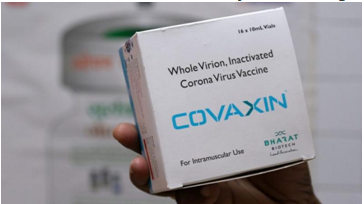
A box containing vials of Bharat Biotech Ltd. Covaxin vaccine. (Photo: Bloomberg/File)
Hyderabad: The Central Drugs Standard Control Organisation (CDSCO) extended the shelf life of Hyderabad-based manufacturer Bharat Biotech’s Covaxin covid vaccine, the company said in a statement on Wednesday.Currently, Covaxin has a shelf life of 6 months with subject to its storage at 2-8 degrees Celsius.
“The CDSCO has approved the extension of shelf life of Covaxin up to 12 months, from the date of manufacture,” the company’s statement read. “This approval of shelf life extension is based on the availability of additional stability data, which was submitted to CDSCO,” it added.
The company also announced that the extension of the covid vaccine’s shelf life has been communicated to all the stakeholders.
Bharat Biotech had earlier in July sought permission from Drug Controller General of India (DCGI) to extend the vaccine’s shelf-life from six to 24 months.
As of now, Covishield of Serum Institute, the only other Covid vaccine being distributed in the country along with Covaxin, has an approved shelf-life of nine months.A shelf life is the expiration date of a vaccine, the time frame within which it retains the same characteristics it possessed at the time of its manufacturing.
Longer shelf life is necessary for vaccine manufacturers since they stockpile vaccines to be used over a period of time. It ensures that the vaccine is safe and of sound quality.
Ranchi Diary
To rule out any confusion between Maoists and villagers, Jharkhand police has banned combat uniforms, used by the security forces, for the common people.
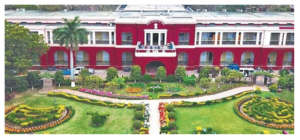
Jharkhand Police bans combat outfits usage
To rule out any confusion between Maoists and villagers, Jharkhand police has banned combat uniforms, used by the security forces, for the common people. According to a notification issued by Jharkhand Police HQ, since combat uniforms are also used largely by hard-core Maoists, it creates a sense of confusion among the security forces during anti-Maoist operations making it difficult for them to differentiate between a Maoist and a common man. The notification issued by IG (Operations) to all IGs, DIGs, SSPs, SPs, directs them take proper action to ensure that people do not wear combat uniforms in their areas and inform police headquarters. Senior Police officials welcomed the decision saying that it would help security forces to rule out the confusion between a Maoist and a common man.
‘Back to School’ campaign to improve attendance
Apprehending low attendance in schools once they open up for junior students of class I-V, Jharkhand Education Project Council (JEPC) has decided to launch ‘Back to School’ campaign for encouraging students to attend their classes regularly. According to JEPC officials, the campaign aims at rebuilding trust among parents that schools are safe, and also to incorporate activities among students to renew their interest in attending in-person classes. The campaign has been basically designed as a trust building programme where communities will be mobilised and and help in persuading them that schools are safe, and that they should send their children back to school. The campaign will be launched, once the schools open up for small children.
28 IIT-ISM professors in top 2% of world scientists
For the first time, 28 professors from IIT-ISM in Dhanbad have made it to the top 2 per cent of scientists in a survey conducted recently by Stanford University which and published by Elsevier. Stanford University has recently released a list that represents the top 2 per cent of the most-cited scientists in various disciplines. Stanford University, every year, announces a list of top 1,60,000 scientists of the world (that makes 2 per cent higher ranked scientists) based on their outstanding publications and citations. The exhaustive list released this year, has 1,59,683 persons with 1,500 odd Indians.
Ranchi airport ranked 5th in customer rating
Birsa Munda Airport at Ranchi has bagged the first position in Eastern India and the fifth position in the country in customer satisfaction and basic facilities provided to the passengers. Airport Council International (ACI), a global body involved in improving security, safety and sustainability of the aviation industry, conducted the survey by seeking feedback of at least 350 passengers who travelled to or from Ranchi. At least 60 airports across India were reviewed during the survey. Ranchi airport officials said the rankings were given on the basis of passengers’ feedback.
Petrol price cut by Rs 12, diesel by Rs 17 in Karnataka
Bommai adds Rs 7 to Rs 5 and Rs 10 reduction announced by Union govt
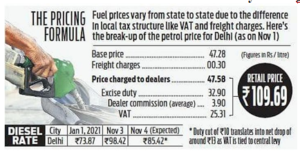
Within a few hours of the Union government reducing the prices of petrol and diesel by Rs 5 and Rs 10 per litre respectively, Chief Minister Basavaraj Bommai announced that Karnataka will reduce the prices of both fuels by another Rs 7. With this, the price of petrol is expected to be Rs 95.5 and diesel Rs 81.5 per litre in Karnataka.This will lead to a revenue loss of Rs 2,100 crore to the state government. Bommai stated that the new prices will come into effect from Thursday evening. “This will be the Deepawali gift from state and union governments,” he tweeted.
The prices of petrol and diesel crossed Rs 100 a few weeks ago. The Opposition Congress had taken up the issue and protested both inside and outside Vidhana Soudha. Leader of opposition Siddaramaiah and KPCC president DK Shivakumar had even mocked the government by riding a bullock cart to Vidhana Soudha during the legislature session.
Now, Gujarat and Sikkim slashes petrol, diesel prices by ₹7 per litre
Buckling under pressure, the Centre cut excise duty on petrol and diesel by a record ₹5 and ₹10 per litre on Wednesday.
A day after the Union Government reduced excise duty on fuel, Gujarat and Sikkim governments have reduced the Value Added Tax (VAT) on petrol and diesel by ₹7 per litre each.
“Chief Minister Bhupendra Patel has announced to reduce the prices of petrol and diesel in Gujarat by Rs 7 per litre,” the Gujarat CMO said in a statement issued late at night.
“ Following Prime Minister Narendra Modi’s decision to reduce the excise duty on petrol and diesel, the Gujarat government has also decided to reduce the VAT on petrol and diesel and implement this reduction in the entire state from midnight,” it stated.
With this decision, petrol will now cost ₹95.13 per litre and diesel ₹89.12 per litre in Ahmedabad, while the two fuels will cost ₹94.89 and ₹88.89, respectively, in Surat.
“…on the auspicious occasion of Diwali, I would like to announce that the State Government will be reducing the prices of Petrol & Diesel in the state by Rs.7/(seven) per liter as a Diwali gift. This will come into effect starting today i.e 04/11/2021,” Sikkim Chief Minister Prem Singh Tamang tweeted.
Together with the reduction of taxes announced by the Sikkim government shortly after midnight, petrol would be cheaper by ₹12 per litre and diesel by ₹17 per litre in the state.
Petrol was retailing at ₹110.60 per litre and diesel at ₹100.80 per litre in state capital Gangtok on Wednesday.
Buckling under pressure, the Centre cut excise duty on petrol and diesel by a record ₹5 and ₹10 per litre on Wednesday.
Petrol costs ₹103.97 per litre in Delhi against ₹110.04 per litre, according to a price notification of state-owned fuel retailers. Diesel rates accordingly reduced to ₹86.67 per litre from ₹98.42 per litre.
In Mumbai, petrol price has been cut by ₹5.87 to ₹109.98 per litre and diesel by ₹12.48 to ₹94.14 per litre. Kolkata saw the price of diesel being reduced by ₹5.82 to ₹104.67 per litre and that of diesel by ₹11.77 to ₹89.79 per litre.
Petrol price in Chennai has been reduced by ₹5.26 to ₹101.40 per litre and diesel by ₹11.16 to ₹91.43 per litre.
Undersea 5.7 earthquake shakes part of eastern Indonesia
The U.S. Geological Survey said the 5.7-magnitude quake struck about 65 kilometers (40 miles) off Amahai, a coastal village on Seram island
A shallow undersea earthquake shook part of eastern Indonesia on November 4, but there were no immediate reports of serious damage or casualties.
The U.S. Geological Survey said the 5.7-magnitude quake struck about 65 kilometers (40 miles) off Amahai, a coastal village on Seram island in North Maluku province. It said the quake was centered about 10 kilometers (6.2 miles) beneath the sea.
The Indonesian Meteorology, Climatology, and Geophysical Agency said the quake was unlikely to trigger a tsunami.
With around 1 million people, North Maluku is one of Indonesia’s least populous provinces.
Indonesia, a vast archipelago of 270 million people, is frequently struck by earthquakes, volcanic eruptions and tsunamis because of its location on the “Ring of Fire,” an arc of volcanoes and fault lines that arcs the Pacific.
The last major earthquake was in January when a magnitude 6.2 earthquake killed at least 105 people and injured nearly 6,500 in West Sulawesi province.
The News Editorial Analysis 3rd November 2021












